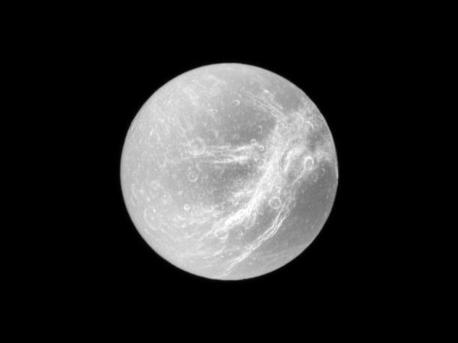Cassini Doubleheader
Close encounter with Dione
 © NASA/JPL/Space Science Institute |
Appearing like the swirls of marble, the wispy terrain of Saturn's moon Dione is captured in a dramatic display of light and dark. These wispy features are a system of braided canyons with bright walls. This view looks toward the area between the trailing hemisphere and Saturn-facing side of Dione (1,123 kilometers, or 698 miles across). North on Dione is up and rotated 1 degree to the left. The image was taken in visible light with the Cassini spacecraft narrow-angle camera on Dec. 26, 2009. The view was acquired at a distance of approximately 644,000 kilometers (400,000 miles) from Dione and at a Sun-Dione-spacecraft, or phase, angle of 2 degrees. Image scale is 4 kilometers (2 miles) per pixel.
This is only Cassini's second close encounter with Dione. The first flyby in October 2005, and findings from the Voyager spacecraft in the 1990s, hinted that the moon could be sending out a wisp of charged particles into the magnetic field around Saturn and potentially exhaling a diffuse plume that contributes material to one of the planet's rings. Like Enceladus, Saturn's more famous moon with a plume, Dione features bright, fresh fractures. But if there were a plume on Dione, it would certainly be subtler and produce less material.
Cassini plans to use its magnetometer and fields and particles instruments to see if it can find evidence of activity at Dione. Thermal mapping by the composite infrared spectrometer will also help in that search. In addition, the visual and infrared mapping spectrometer will examine dark material found on Dione. Scientists would like to understand the source of this dark material.
Cassini has made three previous double flybys and another two are planned in the years ahead. The mission is nearing the end of its first extension, known as the Equinox mission. It will begin its second mission extension, known as the Solstice Mission, in October 2010.
source: NASA
Cassini Doubleheader
Close encounter with Dione
 © NASA/JPL/Space Science Institute |
Appearing like the swirls of marble, the wispy terrain of Saturn's moon Dione is captured in a dramatic display of light and dark. These wispy features are a system of braided canyons with bright walls. This view looks toward the area between the trailing hemisphere and Saturn-facing side of Dione (1,123 kilometers, or 698 miles across). North on Dione is up and rotated 1 degree to the left. The image was taken in visible light with the Cassini spacecraft narrow-angle camera on Dec. 26, 2009. The view was acquired at a distance of approximately 644,000 kilometers (400,000 miles) from Dione and at a Sun-Dione-spacecraft, or phase, angle of 2 degrees. Image scale is 4 kilometers (2 miles) per pixel.
This is only Cassini's second close encounter with Dione. The first flyby in October 2005, and findings from the Voyager spacecraft in the 1990s, hinted that the moon could be sending out a wisp of charged particles into the magnetic field around Saturn and potentially exhaling a diffuse plume that contributes material to one of the planet's rings. Like Enceladus, Saturn's more famous moon with a plume, Dione features bright, fresh fractures. But if there were a plume on Dione, it would certainly be subtler and produce less material.
Cassini plans to use its magnetometer and fields and particles instruments to see if it can find evidence of activity at Dione. Thermal mapping by the composite infrared spectrometer will also help in that search. In addition, the visual and infrared mapping spectrometer will examine dark material found on Dione. Scientists would like to understand the source of this dark material.
Cassini has made three previous double flybys and another two are planned in the years ahead. The mission is nearing the end of its first extension, known as the Equinox mission. It will begin its second mission extension, known as the Solstice Mission, in October 2010.
source: NASA





